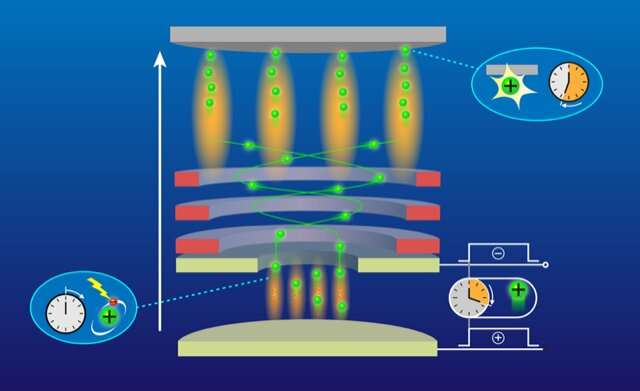Researchers demonstrate an ion-optics-based microscope that can resolve individual charged atoms. The atoms are confined in a one-dimensional optical lattice (bottom of image) and then illuminated with a light pulse, which ionizes the atoms (green balls). After a short delay, the ionized atoms are transferred into the ion-optic system, where they are manipulated with electrostatic lenses (red rectangles) and imaged with an ion detector (top of image). The arrow indicates the direction of travel of the ions through the microscope. Credit: APS/Alan Stonebraker
A team of researchers at Universität Stuttgart has developed an ion-optics-based quantum microscope that is capable of creating images of individual atoms. In their paper published in the journal Physical Review Letters, the group explains how they built their microscope and how well it worked when tested.
Scientists have been pushing the boundaries of microscopy for many years—so much so that current quantum gas microscopes are now able to see objects as small as 0.5μm in size. That is small enough to look at groups of atoms. In this new effort, the researchers have pushed the boundary even further by creating a microscope that images individual atoms.
The microscope built by the team began with the use of an electrostatic lens, a device that can be used to transport charged particles such as electrons. The researchers put three of them together and added an ion detector that was able to single out single ions. Electrostatic lenses work in ways very similar to lenses used in standard handheld cameras or smartphones. But instead of focusing light using a curved surface, an electrostatic lens directs the paths of ions in an electric field. Electrostatic lenses also differ from traditional lenses in that they are adjustable—researchers need only change the voltage applied to the electric field.
The researchers also added a means for confining material to be imaged—for testing, they added ultracold rubidium atoms and held them in a lattice in ways reminiscent of a quantum gas microscope. To create an image, the researchers fired laser pulses at the atoms, resulting in photoionization. This forced the ions to remain in place for approximately 30 nanoseconds. During their time in the lattice, the atoms interacted with each other, resulting in the buildup of many-body correlations. The ions were then released into the microscope, where images were made.
Testing of the microscope showed it capable of capturing features from 6.79μm to 0.52μm with 532 nm spacing between them—enough to allow for creating images of single individual atoms. It was also found to have a depth field of 70μm—big enough to create 3-D images.
More information: C. Veit et al. Pulsed Ion Microscope to Probe Quantum Gases, Physical Review X (2021). DOI: 10.1103/PhysRevX.11.011036
Journal information: Physical Review Letters , Physical Review X
© 2021 Science X Network
























